From the April 2023 issue of Apollo. Preview and subscribe here.
When Gustave Flaubert first encountered Antonio Canova’s sculpture of Psyche Revived by Cupid’s Kiss, it was love at first sight. ‘I saw nothing else in the rest of the gallery,’ Flaubert wrote in his Voyage en Italie in 1845. He returned to the sculpture again and again, and at last kissed Psyche on her armpit, foot, head, and face. ‘Forgive me,’ he pleaded, ‘but it was my first sensual kiss for so long.’ The attraction was more than physical; Canova’s marble transmuted erotic desire into something higher. Flaubert found himself ‘kissing beauty itself; it was to genius that my ardent enthusiasm was devoted.’ Could Psyche’s power possibly be explained, or even put into words? Flaubert thought not. He called ironically on ‘aestheticians’ to ‘define it for me, classify it, label it, wipe your glasses well and tell me why it enchants me’. Dusty scholarship, the measurement of proportions, or the invocation of classical principles, were unlikely to elucidate Psyche’s mysteries. Her power was something to be felt, rather than explained.
Flaubert’s intense reaction to Psyche echoes the classical myth of Pygmalion, who brought his most beautiful sculpture to life with a kiss, turning an abstract ideal of beauty into a living, breathing woman. Canova’s work, more perhaps than any other sculptor’s, hovers between marble and flesh, playing with the boundaries explored by the Pygmalion story. Canova was born in 1757 to a family of stonemasons and sculptors in Possagno in the Veneto, the land of Titian and Giorgione. While his early sculptures were in the late baroque tradition current in Venice, Canova famously developed a more archaeologically informed strain of classicism after his move to Rome in 1781. But he never forgot his roots, nor the renowned sensuality and softness of Venetian painting. As well as being a sculptor, he was also a painter, who delighted in fooling Roman connoisseurs in 1792 with an expertly faked ‘Giorgione’ self-portrait.
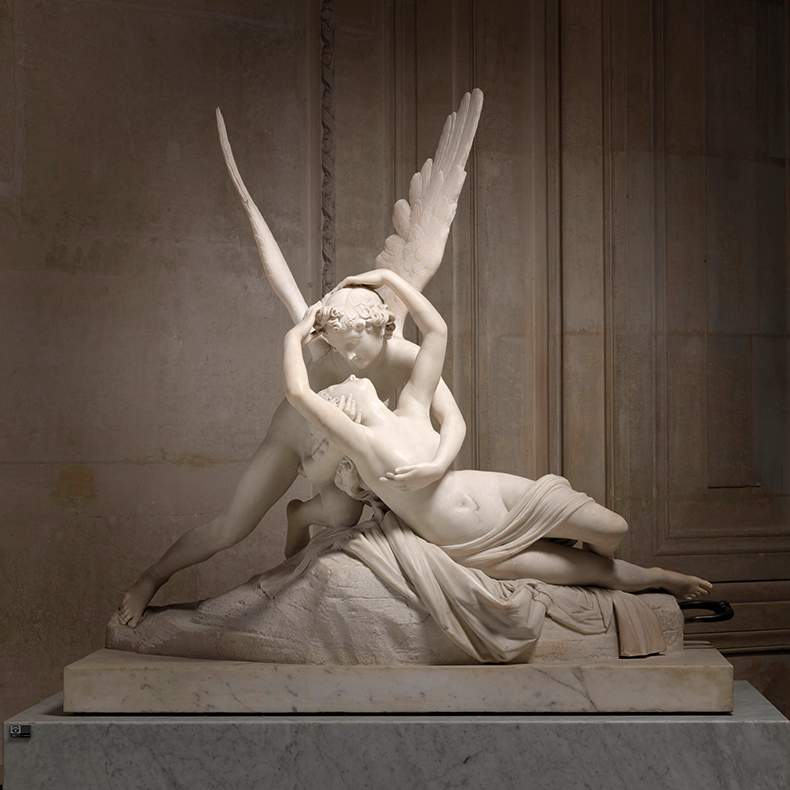
Psyche Revived by Cupid’s Kiss (1787–93), Antonio Canova. Musée du Louvre, Paris. Photo: © 2011 RMN-Grand Palais (musée du Louvre/René-Gabriel Ojéda/dist. Photo SCALA, Florence
The Duke of Bedford, one of Canova’s greatest admirers, praised the morbidezza of his sculptures – a term usually applied to the representation of skin in painting – describing it as ‘that look of living softness given to the surface of the marble, which appears as if it would yield to the touch’. Works such as Psyche Revived offer an unusually haptic – and sometimes erotic – experience, even to those who keep their hands to themselves. The viewer’s eyes are encouraged to act like fingers or lips, caressing the luminous surfaces. This was the result of Canova’s devotion to what he called the ultima mano: the careful, painstaking attention to the final layer of marble, or ‘skin’, of his sculptures. In his studio, assistants were charged with the majority of the carving process. They transferred a composition’s dimensions from a detailed plaster model to the block of marble, roughing it out and bringing it very close to completion. But Canova always stepped in for the final stage of carving, filing and buffing, using an extraordinary attention to detail and a range of tools and techniques to achieve a surface pulsating with life.
It is a common misconception that Canova’s skin is always highly polished. In fact, there is often enormous variety not only between flesh and drapery, but also from one area of flesh to another, from a brushed velvety softness to a cool, glassy gleam. Canova sometimes coated the skin of his figures with a thin layer of wax to soften its appearance, or applied tints to lips and skin, reportedly using horse urine and dirty water to tone down the brightness of white marble. The result – surfaces whose texture seems to defy the rigidity of their material, with hints of blood coursing beneath the skin – provoked scepticism even in some of his most devoted admirers. There was ancient precedent for these practices, as Canova would have known from his friendship with Quatremère de Quincy, the first scholar to suggest that Greco-Roman sculptures were originally polychromatic. Nevertheless, given the hostility to the idea of colouring marble that has persisted from Canova’s time even to our own, it is hardly surprising that none of his coatings remain intact today, having been destroyed by subsequent cleaning.
Canova was reputed to have finished his sculptures by candlelight and many patrons preferred to view them this way too, the flickering play of light adding another dimension of contrast and movement to static works of art. Several of his works stood on pedestals specially designed to rotate, allowing the viewer not only to inspect all angles, but to manipulate the sculpture physically. Did viewers understand this as an erotic as well as a connoisseurial act? Perhaps Canova managed to blur the lines between the two. Although he claimed that the beautiful nude ‘lifts our soul to the contemplation of divine things’, his practice as a sculptor was often understood in terms of less sublimated eroticism. On seeing Canova’s sculpture of Paris, his friend Leopoldo Cicognara mused that ‘[i]f statues could be made by stroking marble rather than by roughly cutting and chipping, I would say that this one had been formed by wearing down the surrounding marble by dint of kisses and caresses’. Two hundred years later, scholars still use similarly charged terms, describing his surfaces as ‘licked’, ‘lubricated’ and ‘slick’.
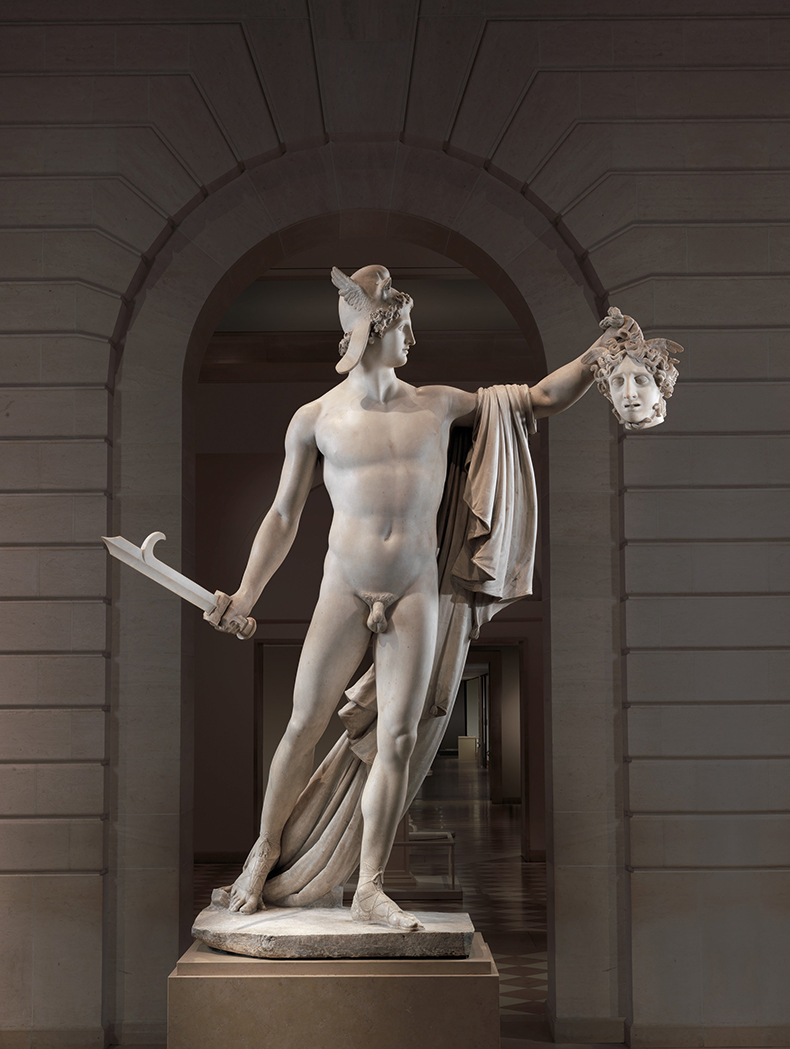
Perseus with the Head of Medusa (1804–06), Antonio Canova. Metropolitan Museum of Art, New York
Despite this erotic reputation, Canova was hailed in his lifetime for resurrecting a purer vision of classicism and for saving sculpture from the allegedly contorted inventions of previous decades, most associated with the legacy of the baroque sculptor Gian Lorenzo Bernini. Canova’s interest in Greco-Roman antiquity had begun as a young man, when he saw plaster casts after the antique at the Ca’ Farsetti in Venice. After he visited Rome, he was surrounded by the remains of antiquity, studying what Johann Joachim Winckelmann called their ‘noble simplicity and quiet grandeur’. Canova followed Winckelmann’s dictum that ‘to become great, and perhaps inimitable’, one had to imitate the ancients. His works were often directly based on a classical prototype – his Perseus incorporates the pose of the Apollo Belvedere, his Venus Italica riffs directly on the Venus de’ Medici, and his portrait subjects were often posed using ancient models. By inviting such direct comparison, Canova demonstrated not only his homage to the past, but also his bravado. For many contemporary critics, Canova showed that it was possible for a modern artist to match and even surpass the ancients, by injecting sensuality and movement into the classical ideal.
Take, for example, The Three Graces, of which he made two versions (one is in the Victoria and Albert Museum, the other in the Hermitage). Ancient sculptures and paintings had typically depicted the Three Graces as a group that could be contemplated from one vantage point: two frontal Graces flanked a central figure with her back turned to the audience, conveniently displaying all the charms of the rear view. But Canova, who had learned from baroque sculpture as well as the antique, arranged his Graces in a loosely entwined circle, encouraging the viewer to walk around the group (or to turn them using the handle on their pedestal) in order to admire every angle. With each slight shift of position, the silhouettes change, revealing a new dimension to the figures’ tender interplay. At the same time, Canova subtly retuned the self-contained, almost impenetrable quality of so much ancient sculpture. His figures may have blank eyes with undrilled pupils, they may look past or turn away from you, as The Three Graces do, but they somehow have just the flicker of a come-hither look. His goddesses and nymphs solicit the viewer’s engagement, whether in the imagination or in physical reality. And to audiences that were accustomed to seeing Greek and Roman sculptures with arms and heads missing, repaired or replaced, and with surfaces eroded and stained from years spent under the earth, the pristinely smooth, finely worked skin of Canova’s forms must have seemed all the more alluring.
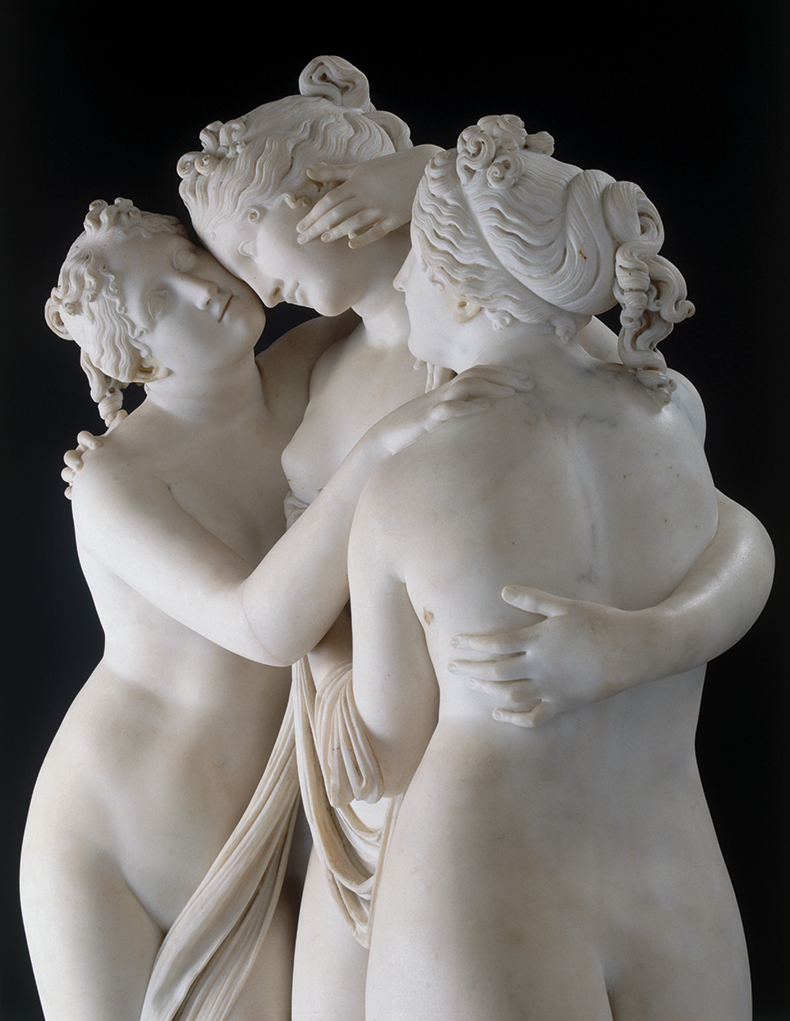
The Three Graces (1814–17), Antonio Canova. Victoria and Albert Museum, London. Photo: © Victoria and Albert Museum
Canova’s modern, revivified version of classicism appealed to the most powerful collectors of his time, from Rome to Imperial Russia. He made portraits of Napoleon and George Washington, funerary monuments for popes, and mythological figures and ‘ideal heads’ for the great and the good across Europe. His studio in Rome, where full-scale plasters and marbles in varying states of finish were theatrically displayed, became a staple of the route of the moneyed Grand Tourist. The Three Graces was originally made for Joséphine de Beauharnais, Napoleon’s Empress and one of Canova’s most devoted patrons. But the Duke of Bedford saw it in Canova’s studio before it was completed and loved it so much that he requested his own version for his seat, Woburn Abbey. (The production of multiple iterations of marble sculptures by a studio was not unheard of, but Canova elevated it to an aesthetic industry.) Once the Graces arrived at Woburn Abbey, they were placed in a specially designed ‘temple’ at one end of the sculpture gallery, becoming the crowning glory of the Duke’s spectacular collection of ancient and modern sculpture.
In 1989, when the Duke’s descendants sold the sculpture to the Getty Museum in Los Angeles, it was subject to an export stop on the grounds of its outstanding importance to the nation. British institutions were given the chance to match the purchase price of £7.6m. But amid the resulting fundraising campaign to ‘Save the Three Graces’, the work’s cultural significance began to be questioned. To some, the sculpture’s classical iconography seemed hopelessly old-fashioned and its white surfaces cold, embodying only an abstract and discredited notion of female beauty. But to others, the sculpture looked like ‘bedroom’ art, with the Graces no more than titillating, cavorting coquettes. In 1994, a group of distinguished art historians, led by Francis Haskell, felt compelled to defend The Three Graces from the charge of being ‘a second-rate work by a minor artist’, reaffirming its position as ‘the most complex and consummate achievement in post-Baroque European sculpture’.
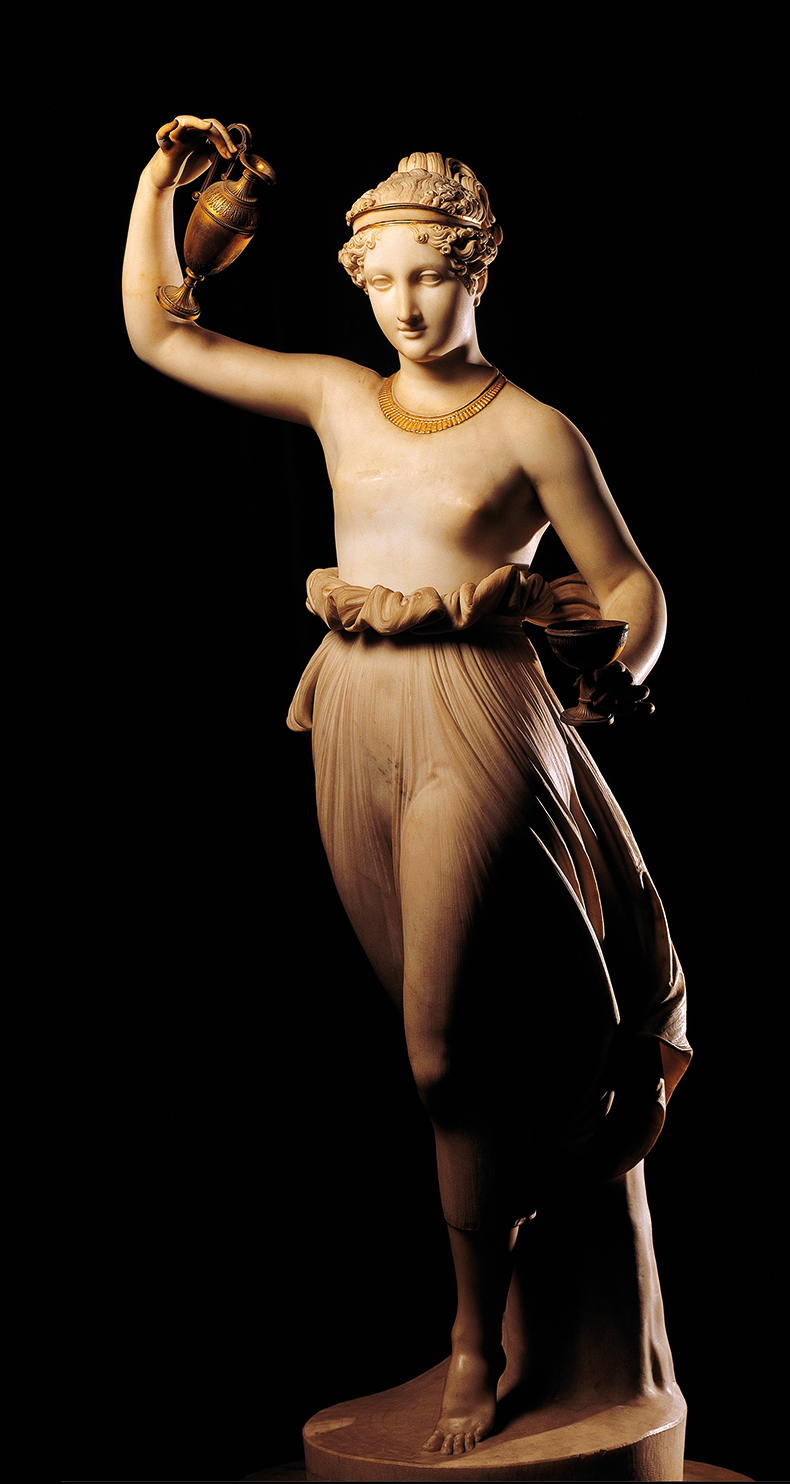
Hebe (1816), Antonio Canova. Pinacoteca Civica, Forlì. Photo: DeAgostini/Getty Images
The Three Graces was eventually acquired in 1994 by the V&A and the National Museums of Scotland jointly, with help from prominent philanthropists and public donations. But the mixed reactions to the sculpture indicate an unease about Canova’s work that was present even in his own lifetime, as David Bindman has explored in his influential book, Warm Flesh, Cold Marble: Canova, Thorvaldsen and Their Critics (2014). While being praised for resurrecting the art of antiquity, Canova was also criticised as a plagiarist, for borrowing too much and too literally from the ancient past. Meanwhile, for classical purists, Canova’s work was too sensual, painterly, and theatrical to be a true inheritor of ancient Greek sculpture. In 1822, the Earl of Minto wrote of ‘the taint of French smirking and opera dancing that offends one in Canova’s studio’; he preferred the Danish sculptor Bertel Thorvaldsen’s more austere, abstracted version of neoclassicism (which accorded with what Winckelmann called the ‘high’ style of Greek sculpture, rather than the ‘beautiful’). Canova’s representations of the goddess Hebe, made in four variations between the 1790s and 1810s, received particular criticism. Not only were her lips and skin originally tinted, but her accoutrements – diadem, necklace, cup and jug – were made of gilt brass, further blurring the borders between representation and reality. In Canova’s time, the gospel of pure white marble went hand in hand with the classical ideal, and his interest in other materials, textures, and colours was often met with bafflement.
While there were rumblings of dissent in his own lifetime, it was from the mid 19th century onwards that Canova’s star really began to fall, as tastes changed and classicism itself – whether that of Canova or Thorvaldsen – became suspect. By the early 20th century, with the advent of modernism, his work looked like one of the last gasps of an impotent tradition. Even in Italy, where he had been revered as a unifying symbol of national genius during the Risorgimento, he eventually came in for opprobrium. In 1949, the Italian art critic Cesare Brandi wrote that the smile of Canova’s Hebe ‘greets you, but freezes you at the same time, like the touch of a corpse’, while the monumental, heroic bodies of Hercules and Lichas were ‘meat in a frigidaire’. Associations between neoclassicism and fascism must have exacerbated this decline; in 1938, Hitler and Mussolini had been pictured in Rome, admiring Canova’s portrait of Pauline Borghese as Venus Victrix. Critical distaste was only heightened by the kitsch associations that Canova had acquired, thanks to the proliferation of mass-produced reproductions of his sculpture for domestic consumption.
From the 1950s onwards, however, Canova began to be rehabilitated by art historians such as Mario Praz, who returned to his sculpture with fresh eyes and asked a question that remains pertinent today: how could one body of work provoke such wildly different reactions, ranging from Flaubert’s enraptured kiss to Brandi’s horrified recoil from a corpse-like body? Perhaps one answer lies in the contradictions inherent in Canova’s sculptures, in the way they seem to oscillate between flesh and marble, softness and impenetrability. One of Praz’s essays on Canova is titled ‘The Erotic Frigidaire’, a term that perfectly encapsulates his reputation for cold anodyne beauty, for sensuality, and even for horror, all at the same time. More recently, William Fitzgerald has described Canova’s work – and neoclassicism itself – as the ‘living death of antiquity’. In sculptures such as Psyche Revived, the classical ideal hovers, like Psyche herself, between life and lifelessness, perhaps even in the realm of the undead.
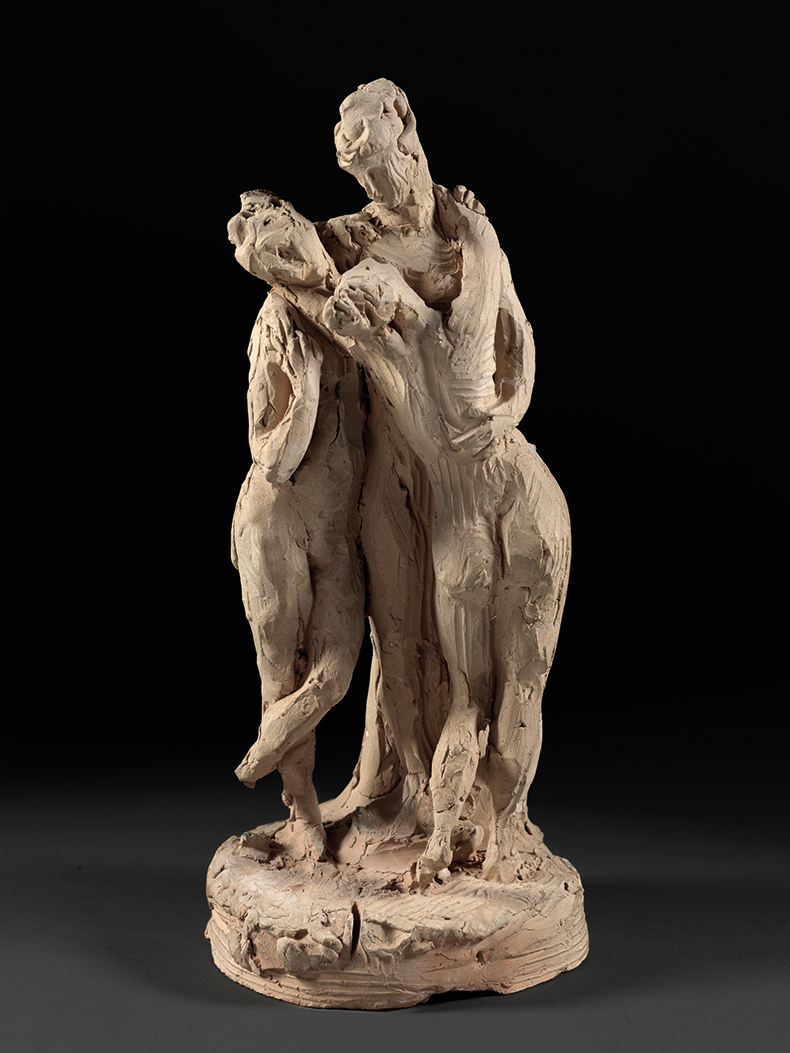
The Three Graces (1812), Antonio Canova. Museo Civico, Bassano del Grappa. Photo: Luigi Spina; courtesy National Gallery of Art, Washington, D.C.
Today, Canova’s place in the art historical canon is uncontested and the bicentenary of his death in 2022 will be belatedly marked this year by a major exhibition in the United States. ‘Canova: Sketching in Clay’, which opens in June at the National Gallery of Art in Washington, D.C. (11 June–9 October), before moving to the Art Institute of Chicago (19 November–18 March 2024), will explore a stage in Canova’s production process that is little known by audiences outside Italy. Canova’s terracotta sketches or bozzetti, most of which are now preserved at the Museo Canova in Possagno, are as loose and free as his final marbles are meticulously finished. Their dynamism and emotional charge complicate any stereotypical understanding of Canova as a controlled classicist. As the exhibition will show, these early compositional experiments were used as the basis for increasingly detailed clay models, resulting in a full-size master model that was cast in plaster and could then be further refined, as shown in Hugh Douglas Hamilton’s pastel portrait of Canova with a model of Cupid and Psyche, his tools arrayed before him. At last, the final composition would be cast in full-size plaster before being ‘pointed’ with black studs so that its dimensions could be precisely transferred to the marble block by studio assistants. This technique allowed Canova’s assistants to bring the marble almost to completion before he returned to lavish his attention on its finish. While the bozzetti bear the visible (and sometimes frenzied) traces of Canova’s fingers and tools, the final skin of his marbles appears so delicate that it is hard to imagine human hands being responsible. As Lord Byron wrote of Canova’s ‘ideal head’ of Helen of Troy, this is ‘art far beyond my ideas of human execution’. If Canova’s marbles seem, paradoxically, to be both intimate and aloof, so too was his working process.
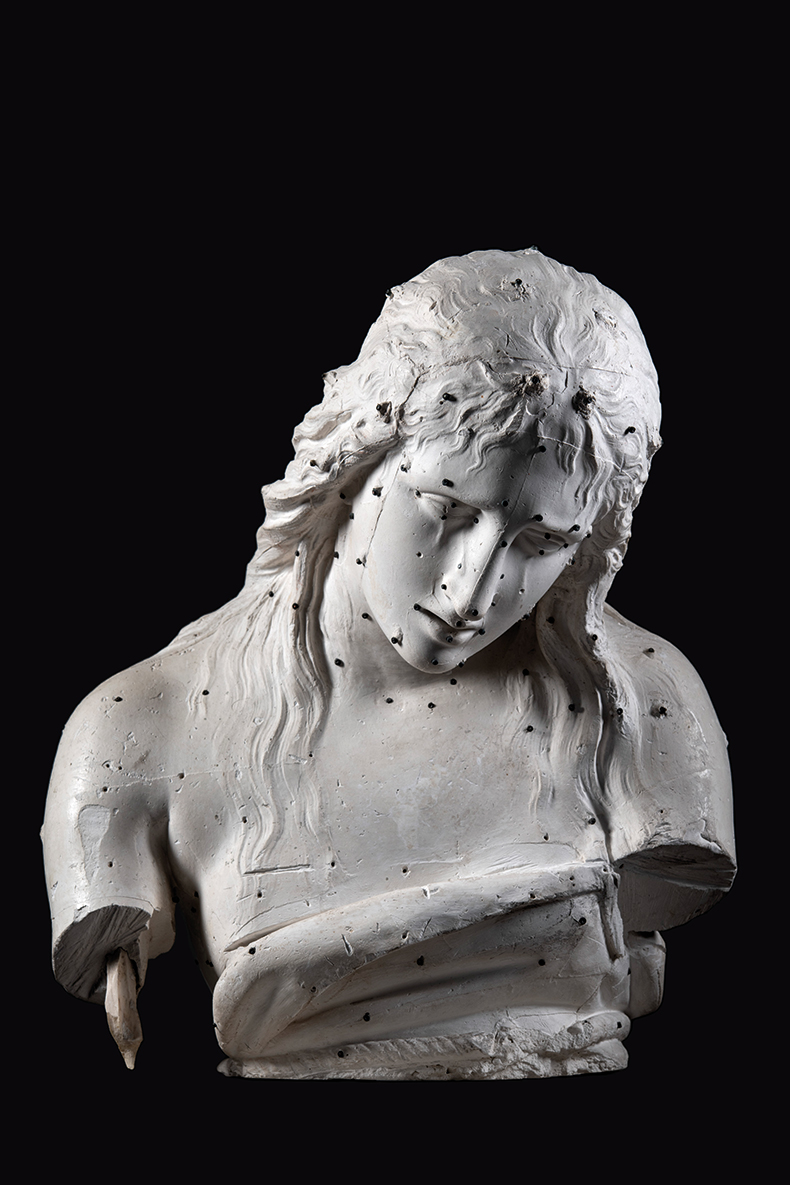
Head of Penitent Magdalene (c. 1794–1809), Antonio Canova. Museo Gypsotheca Antonio Canova, Possagno. Photo: Luigi Spina; courtesy National Gallery of Art, Washington, D.C;
Outside the walls of the academy and the museum, the enduring taste for Canova’s sensual classicism can be seen in the popularity of reproductions of his work. His Venus Italica is marketed for the decoration of ‘garden, spa bath, boudoir or poolside’, for a few hundred or thousand pounds, depending on material and scale. She comes in a white or weathered finish, in composite stone or cast marble with a PU foam filling. But Canova’s aesthetic also lives on in contemporary ideals of female beauty. In recent years, Cora Gilroy-Ware has brilliantly traced a genealogy between Canova’s sculptures and paintings and contemporary fashion advertising, in which the slender, nubile female body becomes a blank canvas on to which anyone’s fantasies can be projected. Today, with the widespread use of digital filters, the availability of relatively cheap cosmetic procedures, and the advent of AI-generated portraiture, the ideal face and body are no longer the exclusive preserve of the worlds of fashion or art. More and more of us, at an ever-younger age, aspire to look like a digitally filtered simulacrum of ourselves, all imperfections removed. Buttocks can be sculpted, brows lifted, lips filled, jawlines remodelled, and cheeks plumped with implants or hollowed out by having their pads of fat surgically removed. The touchstones of this new clinical aesthetic are the images of celebrities and models who have often undergone the same procedures themselves, and who exemplify the 21st-century beau idéal.
Like Canova’s sculptures, the cosmetically enhanced faces and bodies that are prevalent on television and social media often provoke polarised reactions, ranging from erotic worship to outright disgust. Such ‘sculpted’ faces look uncanny because they blur the boundaries between an ideal (or virtual) world and the real one, between Facetuned images and the human body in all its fleshiness. Canova’s female figures and ‘ideal heads’, with their impossibly straight ‘Grecian’ noses and gently swelling throats, may look different to the ‘Instagram face’ popular today. Yet Canova provided a template for an ideal of beauty that seems both hyperreal and implausible, revelling in both its naturalism and its artificiality. Perhaps this is one reason why an ‘aesthetic clinic’ in Mayfair has chosen the name ‘Canova London’. Canova’s legacy is not confined to museums and galleries, or to histories of sculpture and classicism, but can be found all around us, on billboards, televisions, tablets, phones and, of course, in the flesh. Canova’s pursuit of a coolly sensual aesthetic ideal continues, more popular and fraught than ever before.
‘Canova: Sketching in Clay’ is at the National Gallery of Art, Washington, D.C., from 11 June–9 October.
From the April 2023 issue of Apollo. Preview and subscribe here.














![Masterpiece [Re]discovery 2022. Photo: Ben Fisher Photography, courtesy of Masterpiece London](http://zephr.apollo-magazine.com/wp-content/uploads/2022/07/MPL2022_4263.jpg)
‘Like landscape, his objects seem to breathe’: Gordon Baldwin (1932–2025)